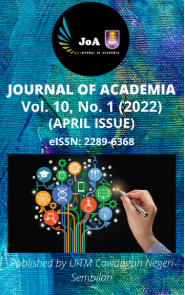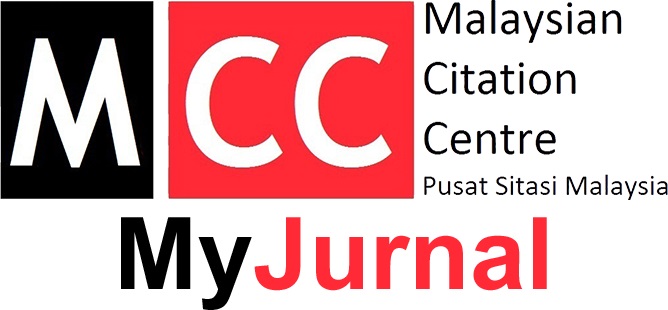EFFECT OF Alpinia galanga EXTRACT TREATMENT ON PHYSICOCHEMICAL PROPERTIES AND ANTIMICROBIAL ACTIVITIES OF COLD STORED FRESH CUT CHICKEN BREAST MEAT
Keywords:
poultry, Alpinia galanga, galangal, antimicrobial, meat quality, chill storageAbstract
The long-term health detrimental effects of chemical additives used in food products cause worries among consumers. Hence, the use of phytochemical compounds as alternatives are being explored by many researchers. This study aimed to evaluate the effect of Alpinia galanga extract on the physicochemical properties and antimicrobial activities of chicken breast meat. The samples were immersed in galangal aqueous extract (0.5, 1.0 and 2.0%), stored at chill temperature (5±1 ºC) and monitored for 8 days. The result showed that the pH of the sample was significantly (p<0.05) increased with the increased concentration of galangal extract used. For colour values, the sample immersed with galangal had lighter colour (L*) compared to the control. During storage, redness (a*) of the control sample was reduced to a greenish hue but no changes were observed for yellowness (b*). Samples with galangal showed a gradual increase in a* and b* until day 4 followed by a gradual decline until the end of storage. No changes in the textural property observed through the penetration force of the control sample were observed. However, the penetration force of only 2% (v/w) galangal immersed sample was found to decrease after day 4. An increase in microbial growth was observed for all samples similar to control with the increase of storage time indicating no microbial inhibition effects. This study points out that the galangal extract used was able to maintain the pH, colour and textural properties of chicken meat. However, a higher concentration of more than 2% galangal extract is required to exhibit the antimicrobial properties needed to prolong the shelf-life of fresh-cut chicken meat.
References
Bakkali, F., Averbeck, S., Averbeck, D., Idaomar, M. (2008). Biological effects of essential oils–A review. Food Chemistry & Toxicology, 46, 446–475.
Barido, F.H & Lee, S.K. (2021). Changes in proteolytic enzyme activities, tenderness-related traits, and quality properties of spent hen meat affected by adenosine 5’-monophosphate during cold storage, Poultry Science, 100(5), 1-10.
Chandrasekara, A. & Shahidi, F. (2018). Herbal beverages: Bioactive compounds and their role in disease risk reduction-A review. Journal of Traditional and Complementary Medicine, 8, 451-458.
Chudiwal, A.K., Jain, D.P. & Somani, R.S., (2010). Alpinia galanga Willd.- An overview on phyto-pharmacological properties. Indian Journal of Natural Products and Resources, 1(2), 143-149.
Ghollasi-mood, F., Mohsenzadeh, M., Housaindokht, M.R. & Varidi, M. (2017). Microbial and chemical spoilage of chicken meat during storage at isothermal and fluctuation temperature under aerobic conditions. Journal of Veterinary Science and Technology, 8(1), 38-46.
Interagency Food Safety Analytics Collaboration (IFSAC) (2018). Foodborne Illness Source Attribution Estimates for 2016 for Salmonella, Escherichia coli O157, Listeria Monocytogenes, and Campylobacter Using Multi-Year Outbreak Surveillance Data, United States. U.S. Department of Health and Human Services, CDC, FDA, USDA-FSIS, GA and DC.
Jayasena, D.D. & Jo, C. (2013). Essential oils as potential antimicrobial agents in meat and meat products: A review. Trends in Food Science and Technology, 34(2), 96-108.
Joo, S.T., Kim, G.D., Hwang, Y.H. & Ryu, Y.C. (2013). Control of fresh meat quality through manipulation of muscle fiber characteristics. Meat Science, 95(4), 828-836.
Juneja, V.K., Dwivedi, H.P., & Yan, X. (2012). Novel natural food antimicrobials. Annual Review of Food Science & Technology, 3, 381-403.
Kahkeshani, N., Hadjiakhoondi, A., Navidpour, L., Akbarzadeh, T., Safavi, M., Karimpour-Razkenari, E. & Khanavi, M. (2018). Chemodiversity of Nepeta menthoides Boiss. & Bohse. Essential oil from Iran and antimicrobial, acetylcholinesterase inhibitory and cytotoxic properties of 1,8-cineole chemotype. Natural Product Resources, 32, 2745–2748.
Kamenik, J., (2013). The microbiology of meat spoilage: A review. Maso International, 1, 3-11.
Kataria, J., Vaddu, S., Rama, E.N., Sidhu, G., Thippareddi, H. & Singh, M. (2020). Evaluating the efficacy of peracetic acid on Salmonella and Campylobacter on chicken wings at various pH levels. Poultry Science, 99, 5137–5142.
Luong N-DM, Coroller L, Zagorec M, Membré J-M, Guillou S. (2020). Spoilage of chilled fresh meat products during storage: A quantitative analysis of literature data. Microorganisms, 8(8), 1198-1225.
Manse, Y., Ninomiya, K., Nishi, R., Kamei, I., Katsuyama, Y., Imagawa, T., Chaipech, S., Muraoka, O. & Morikawa, T. (2016). Melanogenesis inhibitory activity of a 7-O-9′-linked neolignan from Alpinia galanga fruit. Bioorganic & Medicinal Chemistry, 24(23), 6215–6224.
MOH (2017) Health Facts 2017: Reference data for 2016. Ministry of Health, Putrajaya, Wilayah Persekutuan.
MOH (2020) Health Facts 2020: Reference data for 2019. Ministry of Health, Putrajaya, Wilayah Persekutuan.
Nguyen, V. L. & Nguyen, Q. U. (2016). Primary study on the components and main physico-chemical as well as biological properties of the oil of Alpinia galanga (L.) Wild in Phu Tho-Vietnam. African Journal of Biotechnology, 15(48), 2739-2742.
Radha Krishnan, K., Babuskin, S., Azhagu Saravana Babu, P., Sasikala, M., Sabina, K., Archana, G.& Sukumar, M., (2014). Antimicrobial and antioxidant effects of spice extracts on the shelf-life extension of raw chicken meat. International Journal Food Microbiology, 171, 32-40.
Rana, V. S., Verdeguer, M. & Amparo Blazquez, M. (2010). GC and GC/MS analysis of the volatile constituents of the oils of Alpinia galanga (L.) Willd and Alpinia officinarum Hance rhizomes. Journal EssentialOil Resources, 22(6), 521–524.
Ravindran, P.N., Pillai, G.S., Balachandran, I. & Divakaran, M. (2012). Galangal. Handbook of Herbs and Spices, Woodhead Publishing Limited, Cambridge England, 303-318.
Ristic, M. & Damme, K. (2010). The meaning of pH-value for the meat quality of broilers – influence of breed lines. Meat Technology, 51(2): 115-123.
Sripor, W. & Jinda, N. (2014). Effect of Alpinia galangal essential oil on bacteria spoilage. The 26th Annual Meeting of the Thai Society for Biotechnology and International Conference, 26-29 Nov.
Tomasevic, I., Tomovic, V., Ikonic, P., Lorenzo Rodriguez, J.M., Barba, F.J., Djekic, I., Nastasijevic, I., Stajic, S. and Zivkovic, D. (2019). Evaluation of poultry meat colour using computer vision system and colourimeter: Is there a difference?. British Food Journal, 121(5), 1078-1087.
Packiavathy, I.A., Agilandeswari, P., Musthafa, K.S., Karutha Pandian, S., & Veera Ravi, A. (2012). Antibiofilm and quorum sensing inhibitory potential of Cuminum cyminum and its secondary metabolite methyl eugenol against Gram-negative bacterial pathogens. Food Res. Int., 45, 85-92.
Voravuthikunchai, S. (2007). Family Zingiberaceae compounds as functional antimicrobials, antioxidants, and antiradicals. Indian Journal of Natural Products & Resources, 1(2), 143-148.
Zahir, H.G., Saleh, H.H & Mahmud, A.B. (2019). Tenderization efficiency of Cucumis extract (Cucumis trigonus Rox-b) compared with papain enzyme on the aged bull meat by injection method, Al-Anbar Journal of Veterinary Sciences, 12(1), 125-141.
Zhang, H., Wu, J. & Guo, X., (2016). Effects of antimicrobial and antioxidant activities of spice extracts on raw chicken meat quality. Food Science and Human Wellness, 5(1), 39–48.
Zhang, L., Garner, L.J., McKee, S.R. & Bilgili. S.F. (2018). Effectiveness of several antimicrobials used in a post-chill decontamination tank against Salmonella and Campylobacter on broiler carcass parts. Journal of Food Protection, 81, 1134–1141.
Downloads
Published
Issue
Section
License
Copyright (c) 2022 Journal of Academia

This work is licensed under a Creative Commons Attribution-NonCommercial-NoDerivatives 4.0 International License.












